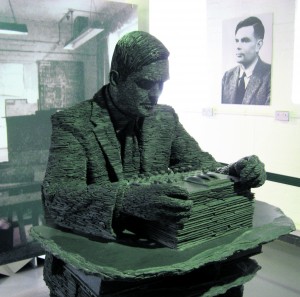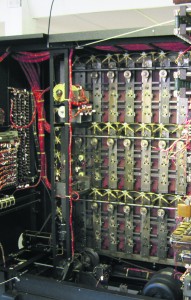WEDNESDAY, 18 JANUARY 2012
Described as the father of computer science, a code breaker in World War II and a pioneer in the world of artificial intelligence, Alan Turing was a remarkable man. He was also a proud homosexual and a runner of Olympic calibre. His untimely death at the age of 41 leaves us wondering just what more he could have achieved. This year marks the centenary of Alan Turing’s birth; celebrations are planned at King’s College, Cambridge, and throughout the world.Turing was born in Maida Vale, London, in 1912. His father was a member of the Indian civil service. As a result, he and his brother John spent a good deal of their youth in foster homes while their parents returned to India. Like many other geniuses both before and after him, as a young boy Turing felt misunderstood and isolated. His loneliness only finally evaporated when he left home for Sherborne School and met Christopher Morcom. Alan idolised his new-found kindred spirit, finding reasons to frequent Morcom’s favourite libraries, exchanging letters and collaborating on scientific projects with him. Morcom’s death during his last year at Sherborne had a great impact on Turing, fuelling an ambition to fulfil his friend’s legacy. There is even speculation that Morcom’s death influenced Turing’s work on artificial intelligence as he analysed the relationship between the material and the spiritual.
Morcom’s death solidified in Turing a determination to improve his grades and earn a scholarship to Cambridge. After two failed attempts to get in to Trinity College, Alan finally received a scholarship to his second choice, King’s College, in 1931. While reading for a degree in mathematics, Turing pursued rowing and later running, while also coming to grips with his sexuality. During this time, he completed impressive work on the central limit theorem in statistics and secured a fellowship at King’s in 1935.
It was then that he turned his attention to a problem posed by a fellow mathematician, producing the Turing machine, which forms the foundation of our modern theory of computation. The Turing machine is a theoretical device able to solve any computable mathematical problem given the appropriate algorithm, or set of instructions. His extension of this concept to a ‘Universal Turing Machine’ arguably paved the way for the modern stored-program computer, in which program and input data share the same memory. Prior to this, computers were either constructed with a single hardwired program or reprogrammed with an external punched tape that had to be fed into the machine.
After obtaining his PhD at Princeton University in 1938, Turing was recruited to work as a cryptanalyst for the Government Code and Cypher School at Bletchley Park. His eccentricities were noted by colleagues. In the summer, Turing would cycle to work wearing a gas mask to prevent hay fever. He also tied his teacup to the radiator to prevent his co-workers from stealing it. Despite his bizarre behaviour, Turing nonetheless emerged as a brilliant cryptanalyst. He devised plans to build a machine called the ‘bombe’, after the original Polish ‘bomba’ machines, to decipher messages from the German encryption machine, Enigma. The bombe was much faster than its predecessor and eventually led to the construction of the Colossus, another successful decoding machine. Towards the end of the war it is said that Churchill would read Hitler’s messages at lunch, while Hitler himself would read them later that day at dinner.
Amidst all this, Turing still found time for romance and drama, befriending a fellow cryptanalyst named Joan Clarke, who soon became his fiancé. After they were engaged, however, Turing confessed to having ‘homosexual tendencies’; Clarke was reportedly unsurprised. Though Clarke was perfectly content to continue their engagement, the scrupulous Turing was eventually moved to call it off. It was after these tumultuous years that Turing was awarded the Order of the British Empire for his work at Bletchley Park, deemed by Churchill to be the single biggest contribution to the Allies’ victory.
After the war, Turing’s work for the Government Communications Headquarters (GCHQ) continued, but the secrecy surrounding the war effort prevented him from disclosing this or any of his significant achievements at Bletchley Park. At the National Physical Laboratory in London, where he took a post, he quickly became discouraged and frustrated by his apparent lack of progress. Turing left before the realisation of his plans for an electronic stored-program computer, the Automatic Computing Engine (ACE), which was later scaled down to a Pilot ACE.
Turing obtained a Readership at the University of Manchester in 1948. Here he began his work on artificial intelligence, devising the Turing test that would provide the means to evaluate a machine’s intelligence. A modification of a popular parlour game, the Turing test deems a machine intelligent if it can converse with a human without giving away its identity. Today the Turing test is implemented in the annual Loebner Prize competition. Turing’s prediction that by the year 2000 a machine would pass the Turing test 30 per cent of the time within five minutes of conversation was an ambitious goal, but the most successful program in the 2008 Loebner Prize competition was only one vote shy of this mark.
Turing clearly found his work stressful, and as such he pursued running throughout his career. During the war, he often reached London by foot when summoned for meetings, running the 40 miles from Bletchley Park. Turing placed fifth in the 1948 Olympic marathon trials with a time of 2 hours and 46 minutes. This was only 11 minutes slower than the Olympic champion that year, a testament to his abilities and to the amount of stress he was under! Unfortunately, an injury prevented him from continuing to run competitively.
Turing’s successful career was also rudely interrupted by a charge of gross indecency. Arnold Murray, a 19-year-old man he met outside a cinema in Manchester, became Turing’s lover in 1952. Soon after they began their affair, Murray and a friend robbed Turing’s home. His young lover felt secure that Turing would not report the theft since it would inevitably require him to admit his homosexuality to the police. Homosexual acts in the United Kingdom, in public and private, were illegal under the 1885 Criminal Amendment Act. Despite this, Turing did indeed report the burglary and in the process of investigation was charged with “gross indecency with a man”. His security privileges as a cryptanalyst were revoked and a year-long regime of forced oestrogen therapy ensued, drastically altering his formerly athletic body.
Despite this setback, Turing coped. Hormone therapy was stopped, and a second Readership was created for him at the University of Manchester in 1953.
Turing’s friends and family were shocked to hear of his death on the 8th June 1954. His cleaner discovered him with an apple lying beside him, with several bites taken from it. The apple was never tested, but it is thought to have been dipped in cyanide. Most believe his suicide stemmed from his persecution as a homosexual. Some, including his mother, hold that his death was an accident, since he’d been experimenting with cyanide and was often careless with chemicals. Conspiracy theorists claim he was murdered to protect the secrets with which he had been entrusted as a cryptanalyst. Whatever the reason, Turing’s premature death robbed the world of one of its greatest minds. It wasn’t until 2009 that Prime Minister Gordon Brown made an official apology for the way Turing had been treated after the war.
Jordan Ramsey is a PhD student in the Department of Chemical Engineering and Biotechnology


